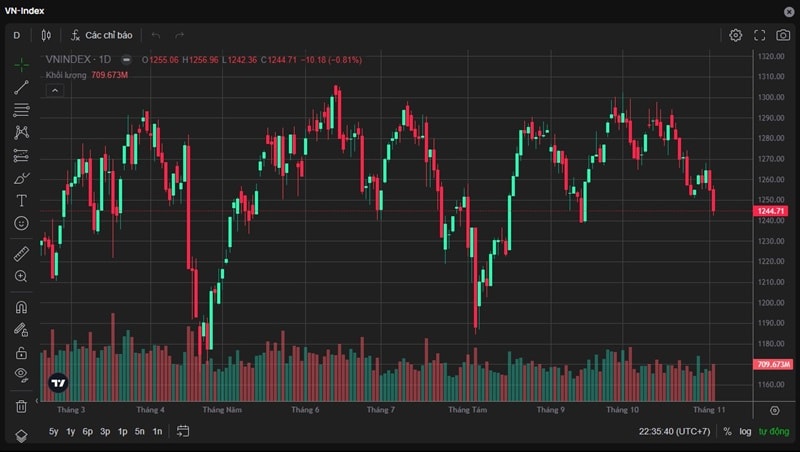Vietnam stock market: Is it time to buy in November?
The Vietnam stock market began the new week with Circular 68/2024/TT-BTC going into force, but foreign investors still sold off many stocks.
Circular 68/2024/TT-BTC states that foreign institutional investors may buy shares on November 2, 2024, without having to have enough money on hand (Non Pre-funding solution, or NPS). Prior to this date, many securities companies confirmed their readiness for this regulation at a briefing conference held by the State Securities Commission.
Long-Term Impact of Circular 68
However, the November 4 session did not meet expectations as it opened the week. By the end of the session, the VN-Index dropped by 10.18 points (0.81%), closing at 1,244.71 points. Notably, foreign transactions continued with net sales on HoSE totaling 673.2 billion VND. Significant sell-offs included MSN (-245.6 billion), VHM (-203 billion), FPT (-101.1 billion), VCB (-47.8 billion), and SSI (-46.3 billion).

The stock market opens the week with a drop, moving below the MA (200) and the 1,251 region.
On the contrary, foreign investors made big purchases in STB, MWG, TCB, CTG, and VPB.
The trend of net selling by foreign investors is expected to continue due to the high USD, negative swap rates, and stagnant market profitability.
Furthermore, it is obvious that Circular 68's fresh regulations did not instantly result in more favorable trading operations.
Mr. Tran Hoang Son, Head of Market Strategy at VPBank Securities (VPBankS), stated that Circular 68 is one of the most important legislation to assist Vietnam satisfy the criteria for an upgrade. Following Circular 68, the most recent FTSE update recognized the work of Vietnamese regulators in permitting international institutional investors to purchase and settle by T2. Vietnam still has to address criteria like foreign ownership limitations and the establishment of a stock clearinghouse.
"I expect these two factors to improve in the future. Currently, this is good news for foreign institutional investors connected with securities companies serving institutional clients because they no longer need to keep cash on hand but can buy shares and settle later if an opportunity arises. We are gradually meeting the stringent standards for an upgrade in the near future," Mr. Son highlighted.
He further noted that trading constraints for funds and organizations are caused by restricted criteria such as the settlement cycle and account registration requirements. "I feel these rules are not very tough, with the harshest standards relating to foreign ownership limitations and stock clearinghouses. These two characteristics require improvement in preparation for the 2025 upgrade cycle, since completing these requirements may result in an official upgrade in September 2025. If the upgrading is announced, the Vietnamese stock market may attract USD 800 million to 1.5 billion in the near future," he stated.
Investment Discipline is Essential
Regarding the current market with a decline in sessions, falling below the MA (200) and the 1,251 region, VPBankS’s Head of Market Strategy noted that a sharp correction would lead to cautious sentiment, especially among investors using technical analysis.

"In risk, there is opportunity" – investors might seize buying opportunities but must not forget the essential discipline of stop-loss.
"We have relatively strong support levels at 1,240 and 1,200, which are ideal balance zones. Thus, I think in the 1,200 - 1,240 range, investors engaging in trading might consider deploying 10–30% of funds on stocks with solid fundamentals, especially those with Q3 earnings growth and substantial discounts.
However, in the short run, the VN-Index is in down trend. Confirming a stable balancing zone, i.e., a mid-term bottom, will take more time, especially given the noise from the US election and the FOMC meeting this week," he added.
In response to the "Buy in November" plan, Mr. Son stated that in prior years, November has marked a bottom, and the market has corrected in the last two months, creating new purchasing chances.
If we look at the VN-Index at 1,300, we can see that stock values are rising despite the lack of large cash inflows. Trading gets difficult once the majority of the favorable news has been reflected in stock prices. Currently, post-Q3 earnings reports show substantial divergence: sectors with weak results are in a corrective period, while those with good 2024 and 2025 growth forecasts provide stock-picking possibilities for December and Q1/2025.
The current trend is influenced by factors like the election and short-term exchange rates. Assuming Mr. Trump wins, the DXY (USD strength index) could continue to rise, prompting foreign investors to keep selling and withdrawing capital, adding pressure on investor sentiment.
"I expect the market to rebalance around 1,200 points, with many stocks approaching or falling below the MA200 level. 'In risk, there is opportunity,' making this a chance to buy stocks for the Santa Rally or holiday wave. We have only November and December to capture this trend, with November as the pivot month," the expert noted on the "Order Matching" program. He emphasized that investment discipline – specifically stop-loss discipline – must come first. If a loss is 5%, a 7% gain is needed to break even; with a 10% loss, a gain of over 15% is required. Therefore, the larger the loss, the harder it becomes to recover profits.








